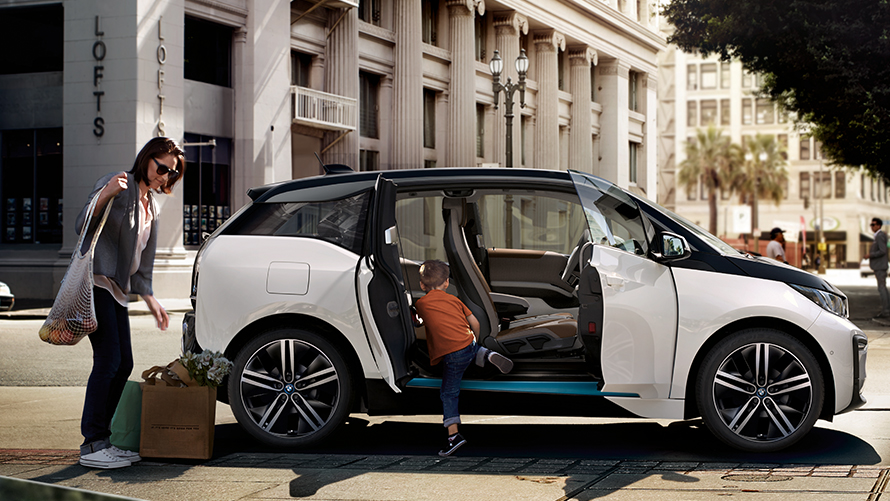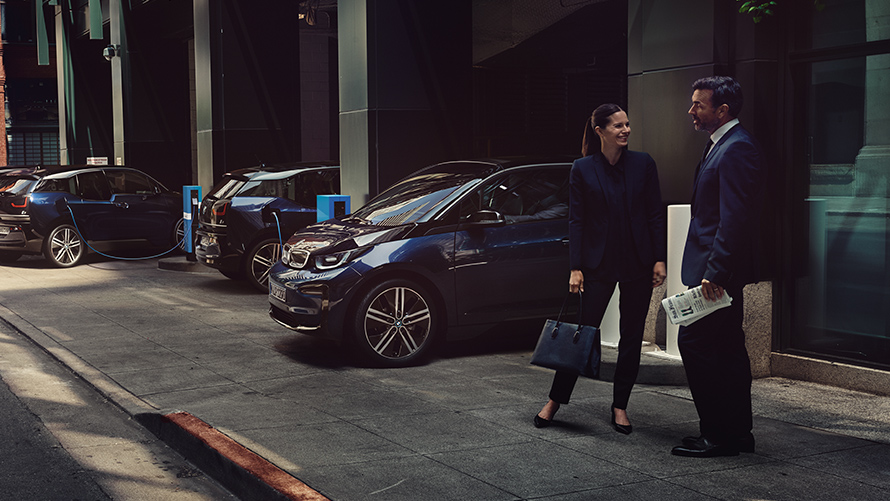Our tool for managing your permission to our use of cookies is temporarily offline. Therefore some functionality is missing.

WITNESS THE SILENT SPARK OF CHANGE.
Experience the BMW i3.
BMW i is a comprehensive and ground-breaking concept for sustainable mobility. It represents visionary electric vehicles and mobility services, inspiring design and a new understanding of premium that is strongly defined by sustainability. And it thrills with its innovative vehicles: the all-electric BMW i3, a locally emission-free car for city driving that is sustainably designed throughout, and the BMW i8 as the most progressive sports car.
BMW i is a comprehensive and ground-breaking concept for sustainable mobility. It represents visionary electric vehicles and mobility services, inspiring design and a new understanding of premium that is strongly defined by sustainability. And it thrills with its innovative vehicles: the all-electric BMW i3, a locally emission-free car for city driving that is sustainably designed throughout, and the BMW i8 as the most progressive sports car.
MORE THAN A CAR.

BMW i.

MOBILITY REVISITED.

A PIONEER OF THE MOBILE FUTURE.

COURAGE AND VISION.

LIFE DRIVE ARCHITECTURE.

THE BORN ELECTRICS.
Since BMW i came into being in 2013, electric pioneers all over the world have been driving, living and sharing our vision of future mobility. On social media platforms they open up their personal spaces, tell us their electric stories and share moments of everyday life with the BMW i3’s.
THE BORN ELECTRICS.
Since BMW i came into being in 2013, electric pioneers all over the world have been driving, living and sharing our vision of future mobility. On social media platforms they open up their personal spaces, tell us their electric stories and share moments of everyday life with the BMW i3’s.

INTELLIGENT SUSTAINABILITY.

DEVELOPMENT.

PRODUCTION.

USE.

RECYCLING.
VISIONARY MOBILITY.

SO CONNECTED, YOU’RE FREE.

CHARGE NOW.

BMW i VENTURES.
DAILY ELECTRIC.

E-MOBILITY FOR EVERY DAY.

DRIVING PLEASURE, FULLY REVISED.

CONVENIENT RECHARCHING AT HOME.

CHARGING WHEREVER YOU ARE.
Fuel consumption and CO2 emissions.
Power consumption and CO2 emissions for the BMW i3 (94 Ah) (3):
Fuel consumption in l/100 km (combined): 0
CO2 emissions in g/km (combined): 0
Power consumption in kWh/100 km: 13.6* / 13.1**Power consumption and CO2 emissions for the BMW i3 (94 Ah) with Range Extender (3):
CO2 emissions in g/km (combined): 14.0* / 13.0**
Power consumption in kWh/100 km (combined): 11.9* / 11.5**
Fuel consumption in l/100 km (combined): 0.6Power consumption and CO2 emissions for the BMW i3s (94 Ah) (3):
CO2 emissions in g/km (combined): 0
Power consumption in kWh/100 km: 14.3
Fuel consumption in l/100 km (combined): 0Power consumption and CO2 emissions for the BMW i3s (94 Ah) with Range Extender (3):
CO2 emissions in g/km (combined): 14.0
Power consumption in kWh/100 km (combined): 12.5
Fuel consumption in l/100 km (combined): 0.7Power consumption and CO2 emissions for the BMW i8 with Plug-In Hybrid BMW iPerformance (3):
CO2 emissions in g/km (combined): 42
Power consumption in kWh/100 km (combined): 14.0
Fuel consumption in l/100 km (combined): 1.9Power consumption and CO2 emissions for the BMW i8 Roadster with Plug-In Hybrid BMW iPerformance (3):
Fuel consumption in l/100 km (combined): 2.1
Power consumption in kWh/100 km (combined): 14.5
CO2 emissions in g/km (combined): 46* Wheels cluster 1: 19‘‘ wheels
** Wheels cluster 2: 20“ wheels; winter tyres
The values of fuel consumptions, CO2 emissions and energy consumptions shown were determined according to the European Regulation (EC) 715/2007 in the version applicable at the time of type approval. The figures refer to a vehicle with basic configuration in Germany and the range shown considers optional equipment and the different size of wheels and tires available on the selected model.
The values of the vehicles labeled with (3), are already based on the new WLTP regulation and are translated back into NEDC-equivalent values in order to ensure the comparison between the vehicles. [With respect to these vehicles, for vehicle related taxes or other duties based (at least inter alia) on CO2-emissions the CO2 values may differ to the values stated here.]
The CO2 efficiency specifications are determined according to Directive 1999/94/EC and the European Regulation in its current version applicable. The values shown are based on the fuel consumption, CO2 values and energy consumptions according to the NEDC cycle for the classification.
For further information about the official fuel consumption and the specific CO2 emission of new passenger cars can be taken out of the „handbook of fuel consumption, the CO2 emission and power consumption of new passenger cars“, which is available at all selling points and at https://www.dat.de/angebote/verlagsprodukte/leitfaden-kraftstoffverbrauch.html.





